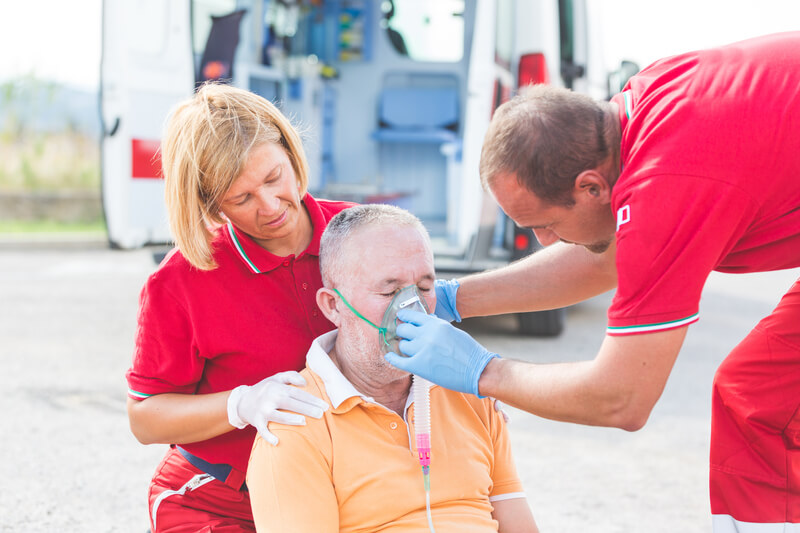Prehospital vs. Inhospital BLS
Prehospital vs. Inhospital BLS

by Greta Kviklyte
Life Saver, AMC
Co-authored by Kim Murray, RN, M.S.
posted on Jun 26, 2025, at 2:41 pm
Basic Life Support (BLS) is a critical level of care used to sustain life during medical emergencies until a patient can receive full treatment in a hospital. Grounded in ILCOR guidelines, BLS includes the timely recognition of life-threatening conditions, high-quality CPR for all age groups, safe use of an AED, and effective response to airway obstruction. It forms the first line of defense in the chain of survival and plays a vital role in improving mortality during cardiac arrest, respiratory failure, acute trauma, and other critical events.
For healthcare professionals, understanding how BLS is delivered in different contexts is key to improving outcomes. While the core principles of BLS remain consistent – rapid recognition of cardiac arrest, high-quality chest compressions, early defibrillation, and effective ventilation – the setting in which BLS is administered profoundly shapes how it is executed, who delivers it, and what resources are available.
We offer Online CPR and BLS Certification
What is Prehospital BLS?
Prehospital BLS refers to basic life support interventions administered outside of a hospital setting, typically by emergency medical service (EMS) providers such as EMTs, first responders, firefighters, or even laypersons trained in CPR. This includes care delivered in the home, workplace, public spaces, or during ambulance transport. In prehospital scenarios, time is of the essence: studies show that each minute of delay in initiating CPR during out-of-hospital cardiac arrest (OHCA) reduces survival by 7% to 10%.
Responders in these environments may be working with limited equipment, challenging environments, or incomplete patient histories, which demand quick decision-making and proficiency in fundamental skills like CPR, AED use, and airway support.
What is Inhospital BLS?
In contrast, in-hospital BLS is delivered by healthcare providers such as nurses, physicians, respiratory therapists, and code response teams working in clinical environments. These interventions take place in settings like emergency departments, intensive care units, general wards, or procedure suites where advanced equipment, electronic monitoring, and clinical support teams are readily available.
Hospital-based BLS is often integrated into rapid response systems or code blue protocols and benefits from access to oxygen supplies, manual defibrillators, intubation tools, and real-time patient data. The clinical environment allows for more structured communication, defined roles during resuscitation, and seamless transition to advanced life support when needed.
What is Basic Life Support (BLS)?
 Each year, more than 350,000 cardiac arrests occur outside of hospitals in the U.S., and 90% of those individuals don’t survive. Every minute that passes without CPR or defibrillation reduces survival odds by 10%. But when someone receives immediate CPR and a shock from an AED, their chances of survival can double or even triple.
Each year, more than 350,000 cardiac arrests occur outside of hospitals in the U.S., and 90% of those individuals don’t survive. Every minute that passes without CPR or defibrillation reduces survival odds by 10%. But when someone receives immediate CPR and a shock from an AED, their chances of survival can double or even triple.
Basic Life Support (BLS) is a standardized set of life-saving interventions used to maintain airway, breathing, and circulation during medical emergencies. It is the foundation of emergency response in both prehospital and hospital settings, particularly in cases of cardiac arrest, respiratory failure, or airway obstruction. BLS is designed to preserve brain and organ function until more advanced care can be delivered.
The primary components of BLS include:
- Cardiopulmonary resuscitation (CPR): High-quality chest compressions combined with rescue breaths help maintain blood flow and oxygen delivery to vital organs during cardiac arrest.
- Automated external defibrillator (AED) use: AEDs analyze heart rhythm and, when indicated, deliver a shock to restore normal rhythm in cases of sudden cardiac arrest.
- Airway management: Basic techniques such as the head-tilt-chin-lift or jaw-thrust maneuver, along with tools like bag-valve masks and oral airways, help maintain an open and effective airway.
BLS training ensures that healthcare professionals can perform these interventions quickly and effectively, whether in the field or in a clinical environment.
Types of BLS Certification
Healthcare professionals can obtain or maintain BLS credentials through one of two course types: BLS Provider and BLS Renewal.
- BLS Provider courses are intended for individuals who are obtaining their BLS credentials for the first time or whose certification has expired. It covers foundational topics, including adult, child, and infant CPR; AED use; team-based resuscitation; and management of choking emergencies. It includes both written and hands-on skills assessments to ensure clinical competence.
- BLS Renewal courses are for professionals who already hold a valid BLS certification and need to renew their credentials, typically every two years. These sessions focus on reinforcing core skills and updating clinicians on any changes in the latest guidelines.
Both certifications emphasize practical, scenario-based training to prepare healthcare providers for real-world emergencies, whether in the field or within the hospital.
Key Differences: Prehospital vs Inhospital BLS
| Prehospital BLS | In-Hospital BLS | |
| Who provides it | First responders, EMTS, paramedics | Nurses, doctors, and hospital-based care providers |
| Situational challenges | Limited equipment, time-critical decisions, unpredictable environments | Access to advanced equipment and support from specialized teams |
| Protocols and equipment | Limited access: portable AEDs. bag-valve masks, spinal immobilization tools | Full access to advanced airway tools, manual defibrillators, and monitoring systems |
| Patient outcome | Unmonitored: Care occurs before hospital-based monitoring can begin | Monitored: Continuous observation and integration with hospital systems |
Prehospital BLS: Training and Delivery in the Field
Prehospital BLS is delivered by emergency medical service providers such as EMTs, paramedics, and other first responders in unpredictable and often resource-limited environments. These providers rely on portable tools like AEDs and bag-valve masks to stabilize patients before hospital arrival. Because monitoring is limited in the field, the focus is on speed, adaptability, and immediate life-saving action.
In-Hospital BLS: Clinical Readiness Inside Medical Facilities
In-hospital BLS is administered by nurses, physicians, and clinical staff in controlled settings with full access to advanced equipment and specialized teams. With continuous patient monitoring and well-established emergency protocols, hospital-based BLS emphasizes coordination, role clarity, and seamless escalation to advanced life support (ALS) when needed.
BLS Course & Certification Options
Healthcare professionals working in both prehospital and hospital environments have multiple options for obtaining or renewing their BLS certification. Training can be completed either in-person or online, depending on the provider’s needs, schedule, and workplace requirements.
In-person training offers hands-on practice with CPR manikins, AEDs, and bag-valve masks, often under the supervision of an instructor. This format is especially valuable for prehospital providers who frequently operate in dynamic environments and benefit from training that simulates real-world conditions like trauma scenes or mass casualty events.
Online BLS certification provides a flexible, self-paced alternative that’s particularly useful for in-hospital providers who already have clinical experience. Online training platforms allow clinicians to review key concepts, refresh their knowledge, and complete required assessments without leaving their workplace or disrupting their schedule.
Regardless of format, BLS certification focuses on a core set of life-saving skills:
- Delivering high-quality chest compressions with proper rate and depth
- Using an AED safely and effectively
- Ensuring scene safety and initiating rapid response protocols
Advanced Medical Certification’s BLS online courses are as thorough, reliable, and widely accepted as traditional classroom certification. Our BLS Certification and Free CPR, AED & First Aid Online Certification courses are designed by Board Certified Physicians. All AMC programs follow the most current ILCOR Standards and Guidelines, are Joint Commission (JCAHO) compliant, and meet ECC/ILCOR and OSHA requirements. Whether you’re seeking initial certification or renewal, AMC offers the same level of credibility and quality as in-person training, with the added benefit of convenience.
Best Practices in BLS Application
 While the fundamentals of BLS are consistent, applying them effectively depends on the provider’s setting. Both prehospital and in-hospital healthcare professionals face distinct challenges that shape how they deliver care. Following best practices tailored to each environment helps reduce mortality and ensure timely, high-quality intervention.
While the fundamentals of BLS are consistent, applying them effectively depends on the provider’s setting. Both prehospital and in-hospital healthcare professionals face distinct challenges that shape how they deliver care. Following best practices tailored to each environment helps reduce mortality and ensure timely, high-quality intervention.
For Prehospital Providers
In the field, the first few minutes of a medical emergency are often chaotic, time-sensitive, and resource-limited. Prehospital providers must rely on preparation, efficiency, and adaptability.
- Prioritize scene safety before initiating care.
- Begin CPR immediately upon identifying cardiac arrest – do not wait for advanced equipment.
- Use AEDs as soon as available.
- Focus on compression quality, especially when working alone or with limited personnel.
- Communicate clearly with team members during hand-offs and transport, documenting critical interventions and timelines.
- Recognize when to escalate to ALS or rapidly transport to a trauma center.
EMS providers who operate in rural areas or face extended transport times may also need to sustain high-quality BLS over longer durations. In these cases, rotating compressors and using feedback devices (if available) can help maintain effectiveness.
For In-Hospital Providers
Within the hospital, BLS is part of a coordinated system of emergency response, supported by specialized teams and equipment. Providers have to focus on both technical skills and team-based dynamics.
- Respond rapidly to code calls and activate the appropriate emergency protocol (e.g., Code Blue).
- Assign and rotate roles clearly (compressor, airway, recorder, and team lead).
- Ensure high-performance CPR, with minimal pauses and frequent reassessment of rhythm and pulse.
- Use available monitoring tools (e.g., capnography, defibrillator feedback) to guide intervention quality.
- Prepare for early escalation to ACLS, ensuring defibrillators, crash carts, and medication access are in place.
- Conduct post-even retrospective to imrpove system response.
Remember: In-hospital BLS success depends as much on communication and coordination as on individual skill. That’s why regular team-based simulations and code drills are essential to maintaining readiness and performance under pressure.
Emergency Medicine Case Studies and Real-Life Scenarios
Example 1: Cardiac Arrest in a Public Setting
At Buffalo Airport, engineer Phil Clough encountered a woman who had collapsed on an escalator. He immediately began high-quality chest compressions while other bystanders called 911 and retrieved an AED. Within seconds of defibrillation, the woman regained consciousness and was talking by the time EMS arrived.
This incident highlights several key prehospital BLS elements:
- Immediate recognition and action (no hesitation to start CPR)
- Rapid use of an AED
- Clear coordination between bystanders and EMS
- It reaffirms data showing early CPR and AED use can double or triple survival chances.
Example 2: Sudden Collapse in a Hospital Ward
In a retrospective study evaluation of resuscitation drills, delays in initiating CPR and activation of code teams were common in the first minutes after a patient’s collapse. The striking simulation study involved 36 unannounced in situ cardiac arrest drills across hospital wards revealed critical delays:
- Time to recognize cardiac arrest: 37 seconds
- Time to first chest compression: another 37 seconds
- Time to call the arrest team: 144 seconds
- Time to first defibrillation shock: 221 seconds
Although equipment and resources were available, delays often stemmed from confusion over roles, unclear leadership, and hesitation in initiating compressions or calling for help. These are precisely the areas that robust BLS training programs aim to strengthen.
Here’s how standardized BLS certification directly addresses these gaps:
- Rapid arrest recognition – teaching staff to identify irregular rhythms and initiate CPR without delay.
- Immediate initiation of chest compressions – minimizing time to first compression.
- Structured team roles and leadership – ensuring someone leads, someone compresses, someone activates the team, and someone finds the defibrillator.
- Prompt equipment use – building confidence to deploy AEDs quickly when needed.
This scenario illustrates that even with the right equipment, delays in application undermine patient outcomes more than a lack of tools.
BLS Across Every Setting
Basic Life Support saves lives on the street, in the ambulance, and throughout the hospital. Each setting presents unique challenges, but the mission is the same: respond quickly, act confidently, and stabilize the patient until more advanced care can take over. From the split-second decisions of a first responder to the coordinated efforts of a hospital code team, effective BLS hinges on training, practice, and preparation.
Advanced Medical Certification makes it easier than ever to stay ready. Our BLS courses are 100% online, based on the latest ILCOR standards, and designed by practicing physicians. You’ll get instant access to exclusive study materials plus an AMA-accredited curriculum that’s fully Joint Commission (JCAHO) compliant. With fast certification, flexible scheduling, and a money-back guarantee, AMC offers healthcare professionals the training they need, on their time.
Be prepared to respond anytime, anywhere. Get Your BLS Certification Online.



